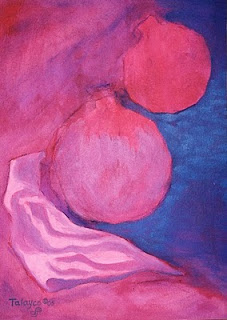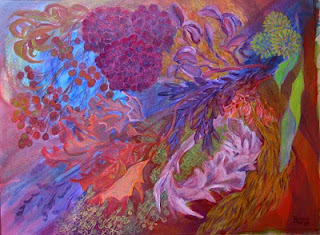
A few years ago, I bought this beautiful plate at a thrift shop's moving sale -- the sale a wondrous occasion for a still-life painter and the plate worth every cent of the $12 it cost me (over-budget for my usual thrift shop browsings). For a long time, it sat on a studio shelf, and occasionally, I'd team it up with different objects and try out small studies like this one:

I tried placing objects to its left, to its right, on top of it, behind it. Nothing moved me, and I came to wonder about my intentions. Did I actually mean to...re-paint this already painted plate? (Little known fact: The young Renoir painted ceramic plates in an early attempt to make a living). Then one day, as I puttered around cleaning up brushes, my eye travelled across a reproduction of a Cézanne painting that I'd posted on my bulletin board:

Voilà. He'd placed an object in front of his plate! So that's what I tried, in a slightly different orientation, when I turned the failed painting "Winter Window" upside-down and planned to start anew.
In early December, winter light was closing in and my thoughts turned to the failed painting, its resurrection, and a salvage project with the blue plate. The red pears just arriving in the grocery store were the very thing, along with the little bottle vase I'd used in the early study. I looked at my quick sketch and at the Cézanne and realized that I also had an ink bottle resembling his so I added it, too.
My aim was by no means to copy or even imitate Cézanne's Le vase bleu (..which would be one awesome exercise and not one I'm up to) -- but just to see where the placement of the plate and the ink bottle would lead me. It led me here, to my "Blue Plate Special" (see how it developed here).
I admit: The ink bottle was a mistake, after all. But I smiled all the way along, thinking how the master artist had guided the placement of my thrift shop plate...and how, judging from his stern self-portraits, he'd have found my travails no laughing matter.






